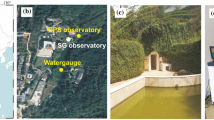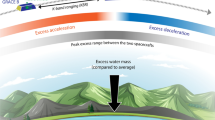Abstract
Monitoring terrestrial water storage (TWS) is critical for global hydrological cycles and important to sustain diverse sectors, such as agriculture, manufacturing, and other industries in many countries. Yet, we have very little knowledge of the spatiotemporal dynamics of TWS changes in the Congo River, which is the world’s second largest river in size (~3.7 million km2), and its discharge is second only to that of the Amazon River (~40,600 m3s−1). Temporal variations in the Earth’s gravitational field likely could be attributed mainly to changes in the TWS in tropical basins. Therefore, the changes in TWS can be monitored based on the Earth’s gravitational field. Although using the Global Navigational Satellite System (GNSS) to measure the gravitational field is prevalent in many regions, this approach has not been considered in the Congo Basin, which is a void. In this paper, we have outlined why it has been suggested to initiate GNSS surveying for monitoring the changes in the TWS in the Congo Basin.

Similar content being viewed by others
Data Availability
The datasets generated during and/or analyzed during the current study are available from the corresponding author on reasonable request.
References
Kim D, Yu H, Lee H, Beighley E, Durand M, Alsdorf DE, Hwang E (2019a) Ensemble learning regression for estimating river discharges using satellite altimetry data: central Congo River as a Test-bed. Remote Sens Environ 221:741–755
Yuan T, Lee H, Jung HC, Aierken A, Beighley E, Alsdorf DE, Tshimanga RM, Kim D (2017) Absolute water storages in the Congo River floodplains from integration of InSAR and satellite radar altimetry. Remote Sens Environ 201:57–72
Chen J, Li J, Zhang Z, Ni S (2014) Long-term groundwater variations in Northwest India from satellite gravity measurements. Glob Planet Chang 116:130–138
Frappart F, Ramillien G, Leblanc M, Tweed SO, Bonnet MP, Maisongrande P (2011) An independent component analysis filtering approach for estimating continental hydrology in the GRACE gravity data. Remote Sens Environ 115(1):187–204
Long D, Longuevergne L, Scanlon BR (2015) Global analysis of approaches for deriving total water storage changes from GRACE satellites. Water Resour Res 51(4):2574–2594
Bhanja SN, Mukherjee A, Rodell M, Wada Y, Chattopadhyay S, Velicogna I, Pangaluru K, Famiglietti JS (2017) Groundwater rejuvenation in parts of India influenced by water-policy change implementation. Sci Rep 7(1):7453
Koster RD, Suarez MJ, Heiser M (2000) Variance and predictability of precipitation at seasonal-to-interannual timescales. J Hydrometeorol 1(1):26–46
Kim D, Lee H, Laraque A, Tshimanga RM, Yuan T, Jung HC, Beighley E, Chang CH (2017) Mapping spatio-temporal water level variations over the central Congo River using PALSAR ScanSAR and Envisat altimetry data. Int J Remote Sens 38(23):7021–7040
Richey JE, Melack JM, Aufdenkampe AK, Ballester VM, Hess LL (2002) Outgassing from Amazonian rivers and wetlands as a large tropical source of atmospheric CO 2. Nature 416(6881):617
Hirschi M, Seneviratne SI, Schär C (2006) Seasonal variations in terrestrial water storage for major midlatitude river basins. J Hydrometeorol 7(1):39–60
Moreira DM, Calmant S, Perosanz F, Xavier L, Rotunno Filho OC, Seyler F, Monteiro AC (2016) Comparisons of observed and modeled elastic responses to hydrological loading in the Amazon basin. Geophys Res Lett 43(18):9604–9610
Ferreira VG, Montecino HC, Ndehedehe CE, Heck B, Gong Z, de Freitas SRC, Westerhaus M (2018) Space-based observations of crustal deflections for drought characterization in Brazil. Sci Total Environ 644:256–273
Ferreira VG, Ndehedehe CE, Montecino HC, Yong B, Yuan P, Abdalla A, Mohammed AS (2019) Prospects for imaging terrestrial water storage in South America using daily GPS observations. Remote Sens 11(6):679
Kusche J, Klemann V, Bosch W (2012) Mass distribution and mass transport in the Earth system. J Geodyn 59:1–8
Herrinck P (1953) Gravity Survey in the Congo Nature 172(4371):258
Hinderer J, Pfeffer J, Boucher M, Nahmani S, De Linage C, Boy JP, Genthon P, Sequis L, Favreau G, Bock O, Descloitres M (2012) Land water storage changes from ground and space geodesy: first results from the GHYRAF (Gravity and Hydrology in Africa) experiment. Pure Appl Geophys 169(8):1391–1410
Jacob T, Bayer R, Chery J, Jourde H, Le Moigne N, Boy JP, Hinderer J, Luck B, Brunet P (2008) Absolute gravity monitoring of water storage variation in a karst aquifer on the larzac plateau (Southern France). J Hydrol 359(1-2):105–117
Naujoks M, Weise A, Kroner C, Jahr T (2008) Detection of small hydrological variations in gravity by repeated observations with relative gravimeters. J Geod 82(9):543–553
Chen JL, Wilson CR, Tapley BD (2010) The 2009 exceptional Amazon flood and interannual terrestrial water storage change observed by GRACE. Water Resour Res 46:12
Frappart F, Ramillien G (2018) Monitoring groundwater storage changes using the Gravity Recovery and Climate Experiment (GRACE) satellite mission: A review. Remote Sens 10(6):829
Lee H, Beighley RE, Alsdorf D, Jung HC, Shum CK, Duan J, Guo J, Yamazaki D, Andreadis K (2011) Characterization of terrestrial water dynamics in the Congo Basin using GRACE and satellite radar altimetry. Remote Sens Environ 115(12):3530–3538
Farrell WE (1972) Deformation of the Earth by surface loads. Rev Geophys 10(3):761–797
Aster RC, Borchers B, Thurber CH (2005) Parameter estimation and inverse problems, 1st edn. Elsevier, Amsterdam, Netherlands, p 316
Argus DF, Fu Y, Landerer FW (2014) Seasonal variation in total water storage in California inferred from GPS observations of vertical land motion. Geophys Res Lett 41(6):1971–1980
Borsa AA, Agnew DC, Cayan DR (2014) Ongoing drought-induced uplift in the western United States. Science 345(6204):1587–1590
Fu Y, Argus DF, Landerer FW (2015) GPS as an independent measurement to estimate terrestrial water storage variations in Washington and Oregon. J Geophys Res Solid Earth 120(1):552–566
Jin S, Zhang T (2016) Terrestrial water storage anomalies associated with drought in southwestern USA from GPS observations. Surv Geophys 37(6):1139–1156
Ouellette KJ, de Linage C, Famiglietti JS (2013) Estimating snow water equivalent from GPS vertical site-position observations in the western United States. Water Resour Res 49(5):2508–2518
Larson KM (2016) GPS interferometric reflectometry: applications to surface soil moisture, snow depth, and vegetation water content in the western United States. Wiley Interdiscip Rev Water 3(6):775–787
Chew C, Small EE, Larson KM (2016) An algorithm for soil moisture estimation using GPS-interferometric reflectometry for bare and vegetated soil. GPS Solutions 20(3):525–537
Larson KM, Small EE, Gutmann ED, Bilich AL, Braun JJ, Zavorotny VU (2008) Use of GPS receivers as a soil moisture network for water cycle studies. Geophys Res Lett 35:24
Syed TH, Famiglietti JS, Rodell M, Chen J, Wilson CR (2008) Analysis of terrestrial water storage changes from GRACE and GLDAS. Water Resour Res 44:2
Khan SA, Wahr J, Bevis M, Velicogna I, Kendrick E (2010) Spread of ice mass loss into northwest Greenland observed by GRACE and GPS. Geophys Res Lett 37:6
Zhao Q, Wu W, Wu Y (2017) Using combined GRACE and GPS data to investigate the vertical crustal deformation at the northeastern margin of the Tibetan Plateau. J Asian Earth Sci 134:122–129
Alsdorf D, Beighley E, Laraque A, Lee H, Tshimanga R, O'Loughlin F, Mahé G, Dinga B, Moukandi G, Spencer RG (2016) Opportunities for hydrologic research in the Congo Basin. Rev Geophys 54(2):378–409
Kim D, Lee H, Beighley E, & Tshimanga RM (2019b). Estimating discharges for poorly gauged river basin using ensemble learning regression with satellite altimetry data and a hydrologic model. Advances in Space Research
Costa S (2018) GNSS infrastructure and services for positioning in Brazil. In: Argentina Workshop on the Applications of Global Navigation Satellite Systems United Nations Office for Outer Space Affairs. Falda Del Carmen, Cordoba, Argentina, pp 19–23 March 2018
Fortes LPS, Costa SMA, Lima MAA, Fazan JA, Galera-Monico JF, Santos MC, & Tétreault P (2006). Modernizing the Brazilian active control network. In Proceedings of the 19th International Technical Meeting of the Satellite Division of The Institute of Navigation (ION GNSS 2006), pp. 2759-2768
Acknowledgements
Station data were obtained from the IGS data centers (https://igs.org/network/). The figure was prepared using the QGIS Desktop 3.4.15 software. Anonymous reviewers, the editor of this manuscript, and Dr. Hyongki Lee have provided valuable inputs that improved the quality of the manuscript.
Author information
Authors and Affiliations
Corresponding author
Ethics declarations
Conflict of Interest
The author declares no competing interests.
Additional information
Publisher’s Note
Springer Nature remains neutral with regard to jurisdictional claims in published maps and institutional affiliations.
Rights and permissions
About this article
Cite this article
Kim, D. Opportunities for Gravity and GNSS Surveying to Monitor Changes in the Terrestrial Water Storage in the Congo River Basin. Remote Sens Earth Syst Sci 4, 121–124 (2021). https://doi.org/10.1007/s41976-021-00049-y
Received:
Revised:
Accepted:
Published:
Issue Date:
DOI: https://doi.org/10.1007/s41976-021-00049-y




